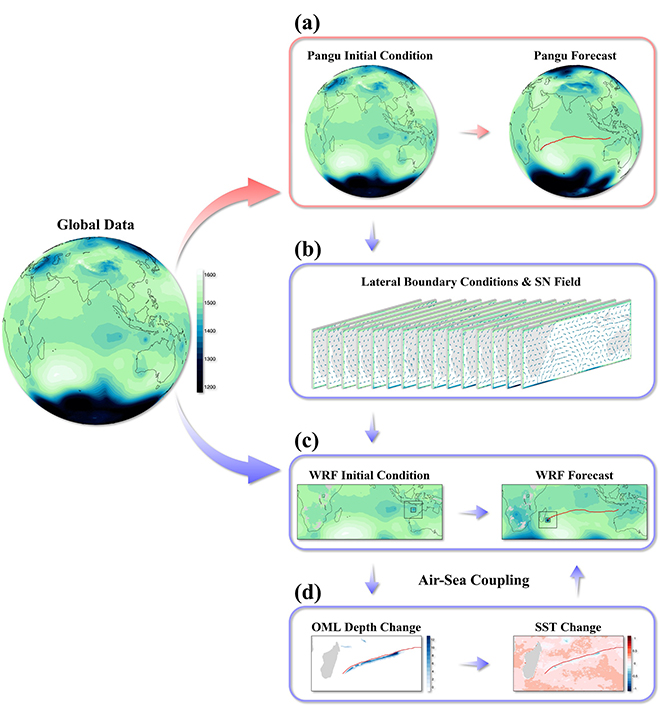2-Week Extended Prediction of Tropical Cyclones by a Hybrid Machine Learning/Physics-Based Modeling Framework
19 July, 2024

Prediction of tropical cyclones (TCs) beyond 5 days and up to 2 weeks has long been a challenge in meteorology and remains a critical gap in operational forecasting. This time span falls within the transition zone between weather and subseasonal scales, requiring consideration of multi-scale systems and enrichment of forecasting methods. The evolution and development of TCs result from the synergistic interaction of track, intensity, and structure. As the forecast lead time extends, this triangular relationship becomes increasingly significant. For example, despite the seemingly straightforward long track of TC Freddy (2023) over the South Indian Ocean, many numerical weather prediction (NWP) models failed to predict it accurately. This exposes the limitations of traditional methods in long-term TC forecasting and highlights the significant constraints on forecast accuracy due to the interactions and error propagation among track, intensity, and structure.
In recent years, machine learning (ML)-based global weather prediction models, such as Pangu-Weather, have demonstrated capabilities comparable to or even surpassing advanced global NWP models like ECMWF in forecasting TC tracks. However, these ML-based models often fall short in improving TC intensity and structure forecasts due to their data-driven approach, which disregards physical laws, and the lack of training data for small-scale atmospheric signals. In contrast, traditional high-resolution regional NWP models, such as WRF, are more effective in enhancing TC intensity forecasts because of their reasonable physical processes and precise depiction of TC structures. Nonetheless, maintaining this capability in long-term forecasts and understanding the underlying theories still require further research.
To address these challenges, we propose a hybrid ML/physics-based modeling framework for 2-week extended prediction of TCs (Liu et al. 2024). This framework utilizes the forecast outputs of the Pangu-Weather model to drive the high-resolution WRF model for 2-week TC forecasts, and adjusts the large-scale environmental fields during forecast period. Furthermore, recognizing the significance of ocean processes in long-term forecasts, the framework incorporates a simple ocean model to facilitate atmosphere-ocean interaction (Figure 1). This framework can fully leverage the respective advantages of the Pangu-Weather and WRF models in TC forecasting. It decreased the two-week mean TC track and intensity errors by 59% and 32% compared to the global numerical weather prediction models, by 2% and 59% compared to the ERA5-driven Pangu-Weather model, and by 32% and 23% compared to the ERA5-driven WRF model, respectively. This implies that the framework has great potential to be used for two-week extended prediction of TCs.
The majority of this work was completed when Dr. Haoyan Liu (刘 昊炎) was a visiting scholar in Professor Masaki Satoh’s group at AORI.
Information of the article
Liu, H.-Y., Tan, Z.-M., Wang, Y., Tang, J., Satoh, M., Lei, L., Gu, J.-F, Zhang, Y., Nie, G.-Z., Chen, Q.-Z. (2024). A hybrid machine learning/physics-based modeling framework for 2-week extended prediction of tropical cyclones. Journal of Geophysical Research: Machine Learning and Computation, 1, e2024JH000207. https://doi.org/10.1029/2024JH000207![]() .
.

Figure 1. Flowchart of the hybrid ML/physics-based modeling framework for TC forecasts. (a–c) The framework uses the forecast outputs of the Pangu-Weather model as lateral boundary conditions to drive the WRF model for 2-week TC forecasts. During simulation, the forecasted wind fields from the Pangu-Weather model outputs are used to adjust the large-scale environmental fields. (c–d) A one-dimensional ocean mixed layer model is used to achieve atmosphere-ocean interaction.
![]()



